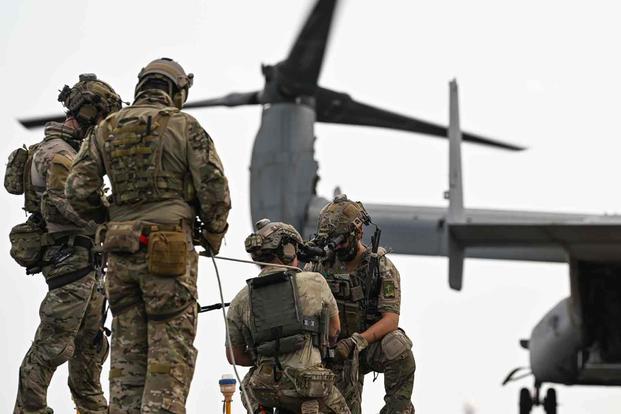
AURORA, Colorado — Air Force Special Operations Command officials want to get their fleet of Ospreys back in the air for missions but are treading carefully following a CV-22 crash that left eight airmen dead in November.
The service is eager to fly the Osprey again but wants more information first, Lt. Gen. Tony Bauernfeind, head of Air Force Special Operations Command, said during a roundtable with reporters Tuesday at the Air and Space Forces Association’s Warfare Symposium conference at Gaylord Rockies Resort and Convention Center.
“There is a strong desire to return to fly because that is a capability we want to have, but we want to be able to return to fly with as much knowledge as we possibly can so that we can ensure that we are safely taking care of our crews as it goes forward,” Bauernfeind told reporters.
The Air Force special operations Osprey that went down Nov. 29, call sign Gundam 22, was on a training mission off Japan’s Yakushima Island. The deadly crash triggered a grounding of all Air Force, Marine Corps and Navy V-22s. That stand-down and multiple investigations into the mishap are still ongoing.
An initial assessment after debris was pulled from the ocean indicated a mechanical failure, raising new questions about the aircraft’s safety. The Osprey fleet had already been under scrutiny following other deadly mishaps and a mysterious mechanical issue, called a hard clutch engagement, that has been seen in the V-22 for more than a decade.
Military.com learned last week that Pentagon safety officials are talking with the Air Force, Marine Corps and Navy about the potential risks involved with flying the Osprey again. The status of the current Defense Department probe, what prompted officials to start talking with the services, and a possible timeline for putting the V-22 back in the air is still unknown.
Bauernfeind told reporters Tuesday that there are “conversations going on at multiple levels,” but added that there are no new findings or timelines to report.
At the Air and Space Forces Association’s conference in Washington, D.C., in September, Bauernfeind told Military.com that the service remained confident in the aircraft a month after three Marines were killed in an MV-22 Osprey crash during training in Australia.
“We’re very confident in the mitigation steps that we’ve done,” Bauernfeind said at that time. “With respect to the CV-22 at large, it is answering a long-held requirement … that no other capability can answer in the special operations community as we go forward.”
Military.com asked Bauernfeind on Tuesday whether he stands by those comments, just months after the Nov. 29 incident marked the deadliest CV-22 crash in the Air Force’s history.
The AFSOC commander seemed more critical of the CV-22, pointing out that it is “1980s technology” and noted that the Defense Advanced Research Projects Agency, or DARPA, has a program looking into an experimental vertical takeoff and landing plane.
But he did reiterate that the CV-22 will not go back into flying status until he is fully confident in its safety.
“I can tell you right now, nothing is more important to me than the safety of our air commandos,” Bauernfeind said. “And when the time is right, when we make that decision to return to fly, it will be with me having the full confidence not only in our training, but our crews, as well as the platform and the new mitigation measures that we have in place.”
In addition to the Air Force crash in November and the Marine crash in August, five Marines died in 2022 when their Osprey suffered a catastrophic clutch failure during training in California.
The causes of the Nov. 29 crash and the August crash in Australia have not yet been revealed.
Bauernfeind said Air Force Special Operations Command has convened a safety investigation board and an accident investigation board; it is also conducting a comprehensive review of the Air Force CV-22 force.
That final review is analyzing whether “the CV-22 force is appropriately organized, trained and equipped for safe, effective and efficient, special operations,” he said.
Search efforts in the Nov. 29 crash involved more than 1,000 personnel, 46 aircraft, 23 maritime vessels, and 21 unmanned air and watercraft looking for wreckage and remains, covering more than 60,000 square kilometers of the ocean surface and 39 square kilometers of the ocean floor, according to the Air Force.
The U.S. military last month concluded its search efforts after 43 days of recovery and salvage efforts. Remains of seven airmen who died in the Nov. 29 mishap were located, recovered and identified during the search off the southern tip of mainland Japan, but AFSOC said in a statement that the body of Maj. Eric Spendlove could not be found.
Last month, Military.com reported that the Government Accountability Office agreed to look into the Osprey incidents following a request by Reps. John Garamendi, D-Calif., and Mike Waltz, R-Fla. The lawmakers asked the agency “to conduct a review on the cause of the accidents that have resulted in several deaths involving the Osprey tilt-rotor aircraft (V-22) during military operations and training exercises.”
Related: Spate of Osprey Mishaps, Including Air Force’s Most Deadly, Will Be Investigated by Federal Watchdog






